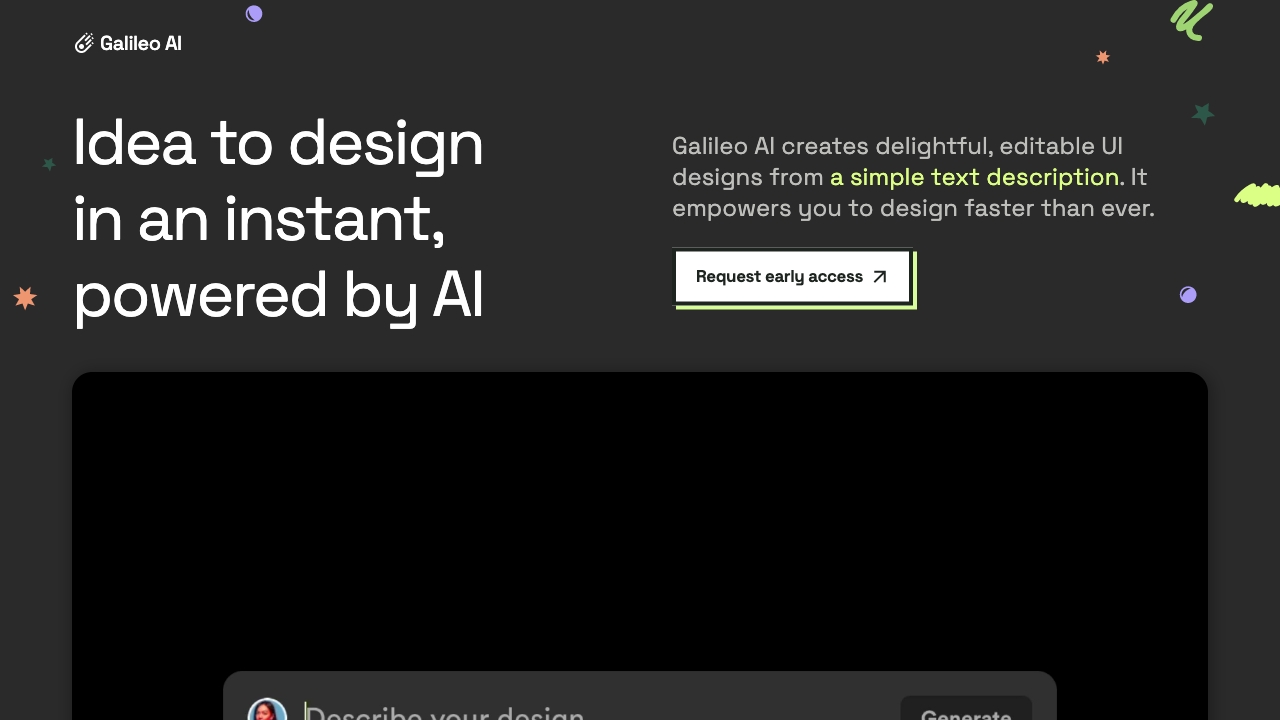- Home
- Image to Image
- Galileo AI

Galileo AI
Open Website-
Tool Introduction:Generate editable UI from text. Design faster with Galileo AI.
-
Inclusion Date:Oct 28, 2025
-
Social Media & Email:
Tool Information
What is Galileo AI
Galileo AI is an AI-powered UI generation platform that turns simple text prompts into high-quality, editable interface designs. It helps product teams, designers, and founders move from idea to polished screens in minutes, accelerating wireframing, exploration, and iteration. By combining natural language understanding with design best practices, Galileo AI outputs layouts, components, and visual styles that can be refined to match brand guidelines. The result is faster prototyping, clearer stakeholder alignment, and a smoother handoff from concept to implementation.
Galileo AI Main Features
- Text-to-UI generation: Transform concise prompts into usable screens and flows for web and mobile.
- Editable designs: Tweak structure, copy, and visual details so outputs fit your product and brand.
- Iterative refinement: Add follow-up instructions to adjust layout, hierarchy, components, or tone.
- Design best-practice guidance: Leverages patterns to produce clean layouts and sensible spacing and hierarchy.
- Style steering: Guide results with brand cues such as color, typography preferences, density, or mood.
- Multi-variant exploration: Generate alternatives to compare concepts and converge on direction faster.
- Handoff-ready outputs: Prepare designs for downstream workflows and asset handoff to your team.
- Tiered usage: Standard, Pro, and Enterprise plans support different scales, limits, and collaboration needs.
Galileo AI Who Is It For
Galileo AI suits product designers, UX/UI teams, founders, product managers, and agencies who need rapid, high-quality interface exploration. It also benefits marketers and no-code builders who want to translate product ideas into tangible screens, as well as educators and students learning modern interface patterns.
Galileo AI How to Use
- Create an account and pick a plan (Standard, Pro, or Enterprise) aligned with your usage needs.
- Write a prompt describing the screen, audience, goal, content, and any constraints (e.g., “responsive pricing page for a SaaS”).
- Generate designs and review variations to identify a promising direction.
- Edit the output: adjust layout, replace copy, swap components, and fine-tune visual style.
- Iterate with targeted prompts (e.g., “denser table,” “emphasize primary CTA,” “lighter color palette”).
- Organize screens, group flows, and prepare assets for team handoff or further production work.
Galileo AI Industry Use Cases
SaaS startups can quickly prototype onboarding, dashboards, and settings to validate MVP concepts. E-commerce teams can spin up landing pages and campaign sections for faster experimentation. Operations groups can draft admin views and internal tools to streamline workflows. Agencies can generate multiple concept directions for pitches, then refine them based on client feedback.
Galileo AI Pricing
Galileo AI offers tiered plans: Standard for individuals and personal projects, Pro for professionals and growing teams needing higher capacity and advanced controls, and Enterprise for larger organizations with custom needs and support. Specific inclusions, usage limits, and commercial terms vary by tier; consult the plan details to choose the right fit.
Galileo AI Pros and Cons
Pros:
- Accelerates ideation and prototyping from natural language to screens.
- Editable outputs make refinement and brand alignment straightforward.
- Reduces the “blank canvas” problem and improves stakeholder alignment.
- Supports rapid exploration of multiple design directions.
- Scales from solo creators to organizations via tiered plans.
Cons:
- Generated designs may require manual polish and brand-specific nuance.
- Quality depends on prompt clarity; some learning curve is expected.
- Highly specialized or unconventional layouts may need extra handcrafting.
- Workflow depends on the platform’s availability and plan limits.
Galileo AI FAQs
-
Can I fully edit the designs generated by Galileo AI?
Yes. Outputs are intended to be edited—adjust layout, components, copy, and styling to match your product and brand.
-
Does Galileo AI replace designers?
No. It accelerates exploration and production, while designers provide direction, judgment, accessibility checks, and brand nuance.
-
How do I steer the visual style?
Include brand cues in your prompt (colors, typography preferences, tone, density) and iterate with follow-up instructions to refine results.
-
What plans are available?
Standard, Pro, and Enterprise tiers address personal use, professional workloads, and organizational requirements, respectively.
-
Does it export production code?
The platform focuses on design generation. Check current product documentation for any code export or developer handoff features.
-
How is my data handled?
Review the vendor’s privacy policy and terms. If you have specific compliance needs, consult the team about Enterprise arrangements.
